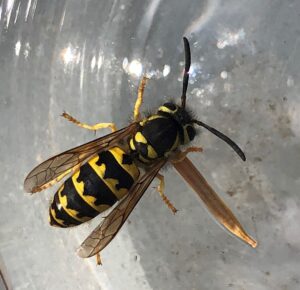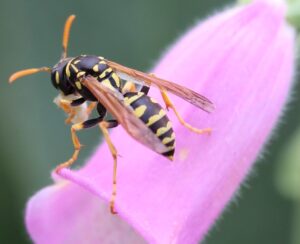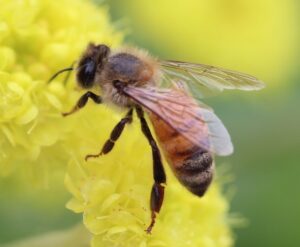Summer and outdoor activities often involve observations and interactions with insects. While most insects are harmless, we do have some species that can sting. Here are the most common stinging insects you’ll find in your backyard.
Western Yellow-jackets

Western yellow-jackets are responsible for 90%+ of all stings in Colorado. When someone says, “I was stung by a bee,” they were likely stung a yellow-jacket.
The western yellow-jacket is much more likely to sting because they are scavengers. Their role in the ecosystem is to be part of the “clean-up crew” by feeding on carrion (dead animals). They also happen to be attracted to human foods, and tend to fly around picnics, BBQs, trash cans, etc. They tend to be more aggressive in the late summer/fall when temperatures cool down and food is harder to find.
Insect Control Options:
- Hang yellow tube traps that use the pheromone heptyl butyrate in March or April to attract queens emerging from hibernation. These traps will only attract yellow-jackets and not beneficial insects like bees. Do NOT use traps that rely on sugar and UV light to attract insects.
- Yellow-jackets build their nests underground. Nests can be hard to find unless they build it close to human activity. If a nest is too close for comfort, consider hiring a professional pest control company. Yellow-jackets will protect their nest if they feel threatened creating a potentially dangerous situation. The nests are well-protected underground, so wasp sprays are not effective. Insecticidal dusts may have limited effectiveness.
Wasps

European paper wasps are an invasive species that have dramatically altered our garden ecosystems. They primarily feed on caterpillars. European paper wasps are social and generally not aggressive, unless you disturb their nest. Stings from the European paper wasp usually happen when humans are unaware a nest is present in a shed, or other dark location. They tend to build nests close to human activity on buildings and other structures, which can increase the chance of nest disturbance.
Wasp sprays can be an effective control option for European paper wasps. Follow direction explicitly for effectiveness and human safety. Apply sprays at night when most of the insects have returned to the nest.
Bees

Honey bees prefer to forage on flowers and work in the hive, but they can sting if they need to protect their colony. They can sting only once. Honey bees have a barb at the end at the end of their stinger that stays in your skin. The barb is attached to the internal organs of the bee, so when the bee tries to fly away, the organs are ripped out of the bee’s body, killing the bee.
If you come across a bee swarm, call the statewide bee swarm hotline at 1-844-SPY-BEES (1-844-779-2337)! Beekeepers will collect the swarm. Bees swarm when they outgrow their hive. They are docile when they swarm, and won’t sting unless provoked.
Bumble bees can sting more than once but will only sting if their colony is disturbed. Bumble bees are not aggressive and prefer to be left alone foraging on flowers.
Insect Sting Prevention
- Leave stinging insects alone. Don’t provoke them.
- If a stinging insect is flying around you, stay calm, and walk away. Do NOT swat at the insect.
If You Are Stung by an Insect:
- Calmly leave the area and go indoors if possible.
- Make sure to tell someone and monitor for an allergic reaction.
- If the honey bee stinger is lodged in your skin, use your fingernail, gauze, or a credit card to scrape the stinger out of your skin. Do NOT squeeze the stinger.
- Wash the sting area with soap and water.
- Apply an ice pack to the sting area to reduce swelling.
- If you have a known allergic reaction, consider asking your doctor about carrying an epinephrine pen. Consider wearing a medical identification bracelet stating your allergy.
For more information, contact your local CSU Extension office.
To learn more about bees visiting your gardens, visit NativeBeeWatch.org.


Thanks for the info! Good to know.
Thanks for this informative article.